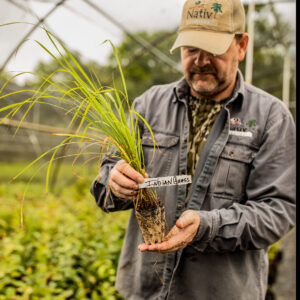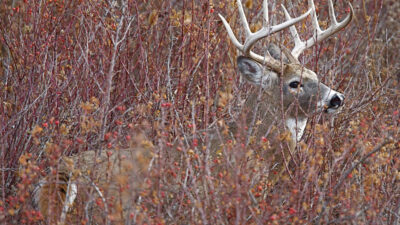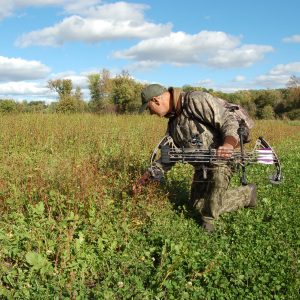When you consider the “perfect” food plot, do you envision pristine clover fields, brassicas with huge leaves or knee-deep soybeans? If your idea of a dream food plot resembles a well-manicured lawn, your dream may be more of a nightmare for the wildlife that you hope to feed with it.
Gamekeepers who consciously create plots for the overall welfare of wildlife should also consider ways to improve the cover in and around the plot. Cover not only helps small game to thrive within the plot, but perimeter cover can be the catalyst that extends that long-tined buck the comfort he needs to approach and then ultimately enter your plot.
Creating a plot that is more inviting to wildlife can be accomplished in many low or no-cost ways. Don’t discount these ideas because they’re thrifty, since their dividends can be exponential.
Hinge Cutting Trees
Since many food plots are near stands of timber, you may be tempted to fell perimeter trees to limit shading of your plot and let the sun in. While allowing light into your plot will possibly enhance plot growth, you may, in fact, inhibit the use of your plot by some small game animals. Let me also say that in certain cases you may want the shade on the plot to help conserve soil moisture – every setting is unique.

The staging areas around a plot should provide an important sense of security for vulnerable whitetail fawns and turkey poults as they search for food along-side the hen. And more importantly for some, it provides a feeling of security to mature bucks so they will show up earlier during the day and spend more time at the location because of the feeling of safety. Instead of completely cutting all the small trees you may want to consider a hinge cut in varying locations.
Hinge cutting a tree is a simple method of felling trees, but leaving half or more of the tree attached to the stump. The treetop will fall to the ground and continue growing for a few years. This creates “living cover” that will be added to with an increase in stem density and additional brush because the sunlight is now able to reach the soil.
As simple as it may sound, hinge cutting can be dangerous if you have little experience with a chainsaw. You should avoid hinge cutting trees that are larger than eight to ten inches in diameter because larger trees are more top heavy and increase the risk of splitting out or kicking back on you. Cut until the tree begins to fall (or you can push it over), step back and let gravity do its work. Nearly half of the tree will remain intact with the stump which allows the tree to continue growing.
Any tree variety can be hinge cut, but hearty tree varieties such as maple or poplar will create the best grow back.
Elevated Brush piles
Creating brush piles in or along the perimeter of a food plot can provide quick cover for small game and a back drop for a mature buck to nestle in against. Elevated brush piles have been proven to last longer and be more effective cover than simply placing the piles on the ground. When piles are flat to the ground they will decay much more quickly and inhibit small game animals’ ability to enter and exit the pile.
To create an elevated brush pile, concrete blocks, treated timbers, or other decay resistant materials are first placed directly on the ground. Basic support structures such as old metal gates or wire cattle panels are then placed on top of the blocks to support the brush. This creates ample clearance beneath for rabbits, quail and turkey poults. Stack the brush directly onto the elevated surface in a crisscross fashion. The brush will not decay as quickly and will prevent predators such as fox from creating dens. Vertical branches should then be placed into the top to create natural “fly in” lanes for small game birds as they seek refuge.
Plow Perch
Consider your hard to reach field corners and field edges as prime locations for a plow perch because it will create excellent staging areas as well as a low maintenance plot improvement.
The soil will need to be disked or plowed, and then t-posts are placed in a grid pattern into the ground. The posts should be 12 to 15 inches apart. A smooth wire is run to each t-post creating a checkerboard array. The wires will allow grassland birds to perch on the wire and deposit seed from shrub species in their droppings. The seeds then germinate and create woody cover.
The woody, shrub cover such as blackberry and raspberry will be well-established in two to three growing seasons, the t-posts and wire can be removed and placed in additional areas where woody cover is needed, or left to add stability to the growing plants or the ability to crawl up the wire.
Of course, you should only use the plow perch if you are willing to dedi-cate the plot area for the long-term because best results won’t be seen for at least two to three years.
Warm Season Native Grasses for Deer Cover
 Native Warm Season Grasses (NWSG) creates natural cover because of how they develop. Their greatest value comes primarily from the fact that their growth structure provides “bunch” grasses rather than sod-forming grasses such as fescue. The bunch nature of warm season grasses allows young quail chicks, new born fawns and turkey poults the opportunity to travel through these stands with overhead protection from the tall grasses. Additionally, it allows them to follow the “tunnels” and pathways beneath in pursuit of insects or other food.
Native Warm Season Grasses (NWSG) creates natural cover because of how they develop. Their greatest value comes primarily from the fact that their growth structure provides “bunch” grasses rather than sod-forming grasses such as fescue. The bunch nature of warm season grasses allows young quail chicks, new born fawns and turkey poults the opportunity to travel through these stands with overhead protection from the tall grasses. Additionally, it allows them to follow the “tunnels” and pathways beneath in pursuit of insects or other food.
It’s important to note that native warm season grasses are not planted as a food plot. Instead, they are plant-ed to enhance cover within the plot. They are most effective when they are grown alongside legumes such as clover. Quail, turkey poults, and other vulnerable wildlife can feed on the legumes while benefiting from the cover provided by the native warm season grasses. A variety of native grass seeds are available at the Game-keepers online store. As it is with many food plot cover enhancement projects, the best results from native warm season grasses may not be seen for two to three seasons.
Tall Food Plot Options

Alsheimer
Simply due to their tall nature, field corn, soybeans and wheat provide awesome cover. Field corn varieties can reach heights greater than eight feet and browsing deer and turkeys will find protection within the rows. The ears of corn are several feet off the ground and will hang on the stalk for quite some time, this creates lasting cover and sustenance during the late fall and winter months when natural food is most scarce.
Deer will feed on the corn within the safety of the tall stalks and smaller game will feast on what the deer knock down or drop. In some cases, the stalks will stand until the following spring when it will be time to replant. Tall varieties of field corn can also be planted along the perimeter of your shorter food plots to create a visual barrier.
While winter wheat and soybeans don’t reach the same height as field corn, each can grow up to and beyond three feet in height once they mature. Both plants are relatively fast growing and each creates excel-lent cover for small game. Deer will love the tender winter wheat as it grows. However, turkeys will especially benefit from the seeds created by the winter wheat when it reaches maturity. Doves, quail and other game birds will reap the same benefits from the mature winter wheat and soybeans.
Placing narrow strip plots of winter wheat or soybeans between corn plots creates added assurance for wary animals as they move from one plot to another. Another positive attribute of winter wheat is the fact that it is suitable for both fall and spring plantings. The fall plantings will reach their maximum height and mature just in time to provide cover for spring poults. The seed heads will be mature and hens will knock the seeds to the ground so that the poults can feed within the cover of the wheat.
Food Plot Visual Barriers
 If your fields or food plots are within sight of someone else’s hunting grounds or a roadway, you may need to create perimeter cover to provide a visual barrier. You don’t want to advertise the game on your property to everyone who drives by. Depending on your region you can choose fast growing evergreens such as white pine or spruce that will create a visual barrier or a combination of deciduous trees or NWSG such as BioLogic’s Blind Spot and evergreens. Such a buffer will also make skittish animals more likely to enter your plot area.
If your fields or food plots are within sight of someone else’s hunting grounds or a roadway, you may need to create perimeter cover to provide a visual barrier. You don’t want to advertise the game on your property to everyone who drives by. Depending on your region you can choose fast growing evergreens such as white pine or spruce that will create a visual barrier or a combination of deciduous trees or NWSG such as BioLogic’s Blind Spot and evergreens. Such a buffer will also make skittish animals more likely to enter your plot area.
Ideally you should plant white pines or spruce at least 12-16 feet apart. Since the branches can span up to 25 feet, thinning may actually be necessary as they grow. Planting several rows and staggering the trees will help fill in bare spots until the trees fill out. Branches and entire trees that are removed can be used to create additional cover with the mentioned elevated brush piles. If you plant more than one row you should space the rows about twenty feet apart. White pines can grow up to twelve feet in height in just five to seven years. Their vigorous growth and dense branches and needles make them ideal for the creation of a visual barrier.
Go with Natural Deer Cover
Sometimes the most effective improvement may be to do nothing at all. Natural cover procreates and spreads without the aid of anyone. Keeping natural woody vegetation trimmed away from the edges of your food plots may improve the overall appearance of the plot, but may in fact hurt its appeal to wildlife. Of course, you do want to control its growth and encroachment on your plot, but allowing a natural barrier of five to ten feet around the perimeter of the plot will improve the quality cover for all game. Best of all, it costs nothing. You can give it some fertilizer to increase growth and browse appeal. Fawns, poults and other vulnerable wildlife will find refuge in the dense cover that is created.
Creating and maintaining effective food plot and cover programs requires attention to the smallest details. Thankfully there are strategies for enhancing your plots that add security and cover without breaking the bank. Gamekeepers who have good “cover sense” will soon discover that “making cover” instead of “taking cover” can be the key to long term benefits for their wildlife.







